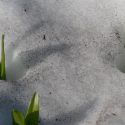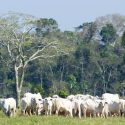For UW-Madison scientists, Northern Wisconsin serves as a lab and a classroom
Ankur Desai stands in front of the 27-meter-tall Willow Creek flux tower, which is tucked into the woods west of Minocqua, a few feet from a logging road. View a slideshow of Desai’s work at the UW’s Kemp Natural Resources Station.
For the past decade, Ankur Desai has been working with collaborators from across the country to study the uptake and emission of carbon in northern Wisconsin’s forests, wetlands and lakes.
And when Desai measures greenhouse gases, he’s not just helping to illuminate how ecosystems modify climate. He’s also igniting the spark of scientific inquiry in local students.
Northern Wisconsin is home to a band of temperate hardwood forests and a significant accumulation of peat bogs. “It’s a combination where you have a lot of carbon in the system and you have very productive organisms that can cycle carbon,” says Desai, an associate professor of atmospheric and oceanic sciences and affiliate of the Nelson Institute Center for Climatic Research (CCR).
His research combines observational and modeling techniques. He’s placed a network of towers — ranging from 30 to 1,200 feet tall — throughout the region to capture continuous atmospheric measurements. By taking readings as many as 20 times per second, the towers infer the amount of carbon dioxide and methane — another important greenhouse gas — going in or out of the system.
Desai’s lab, which is a leader in the use of this technology, has discovered that the region is quite sensitive to climate extremes, though with lags in the system. For instance, the drought that affected much of Wisconsin in the summer of 2012 was delayed in reaching the northern part of the state. But once the drought hit, it shut off production in some of the forests, in a way that was far stronger than expected.
Wisconsin forests are not typically limited by moisture, so they lack adaptation to long periods of drought. “They turn out to be pretty sensitive,” Desai says.
Desai’s observations are helping to refine models of future climate feedbacks. “If, as we suspect — and as projections indicate — Wisconsin is getting drier in the summer and warmer in the winter, then that has huge ecosystem implications for the productivity of forests,” he says.
The work also has value outside of the state, as some of Desai’s measurements are being shared with global data networks to be used by ecologists and climate scientists from across the world.
“CCR is a research-oriented center, but we’ve been learning over time that our mission is useless if we’re not communicating that knowledge broadly and widely, and not just to experts in science,” says Desai.
“The Wisconsin Idea compels us to make sure our research and teaching benefits the entire state. For me, doing research in northern Wisconsin, it was important to work with people who live and study there.”
For years, Desai has coordinated with the College of Menominee Nation in Keshena to bring students into the field as climate researchers. He organized several multi-day courses supported by a five-year National Science Foundation grant that included an outreach component. The grant concluded in the summer of 2014.
While course participants contributed to Desai’s field observations, his larger goal was to expose the students to scientific careers. The project targeted community college and tribal high school students who might want to pursue advanced degrees in environmental science.
“The more you get students doing hands-on science, the more you pique their interest in potentially doing this as a career,” he says.
The important part of this outreach is that the students are in a community of other scholars, says Desai, and he routinely introduced Menominee students to graduate students from his lab.
“Every student has their own story about how they got into the field, what struggles they had, how their research is going,” he says. “For the Menominee students to learn those stories and for them to share their own, it really helps everyone get a better understanding of what’s going on there, which can undoubtedly improve research.”
Subscribe to Wisconsin Ideas
Want more stories of the Wisconsin Idea in action? Sign-up for our monthly e-newsletter highlighting how Badgers are taking their education and research beyond the boundaries of the classroom to improve lives.



